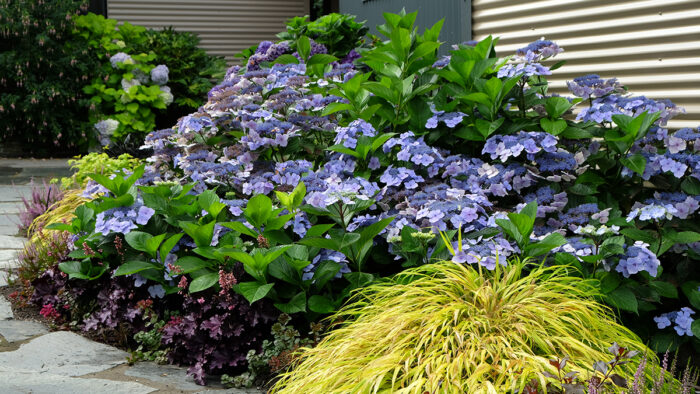
Although hydrangeas (Hydrangea spp. and cvs., Zones 4–10) are extremely popular and seen everywhere, how to grow them is a widespread mystery. The types available are many and varied. The way they are cared for is also just as varied. Often this mystery leads to disappointing bloomless shrubs for many gardeners. Others are discouraged by a stunted, sun-scorched, shriveled plant that eventually needs to be removed. Equally disappointing is a misplaced hydrangea too close to a path or driveway, which leads to unsightly broken branches or the need to heavily prune and disfigure the prized plant to reduce its size. As with many things, a good location and attention to details will make all the difference in the world when it comes to adding these beautiful shrubs to any garden. Here are a few tips and hacks that will help solve the mystery of growing and enjoying hydrangeas.
All hydrangeas benefit from some shade
Most species like a bit of sun, but usually morning or midday light is best. Hot afternoon sun can cause scorching of leaves and reduced size of blooms. Hydrangeas planted in full shade will often have bigger leaves, blooms, and overall size.
Water is important
Dry soil will result in shriveled leaves and reduced blooms. Summer water is appreciated by all types of hydrangeas. They don’t like to compete with large trees for space and water.
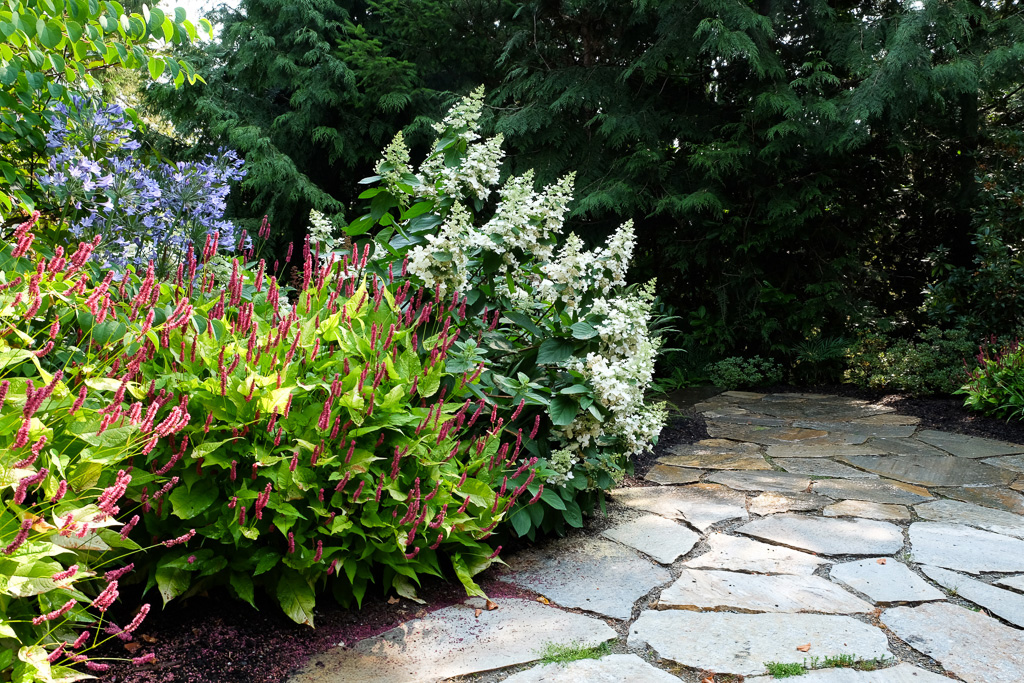
Good soil with organic mulch makes them very happy
Sometimes roots on hydrangeas will creep above the soil or just under the soil surface. Mulching your shrubs with compost, leaf mold, or fine composted bark will feed them and keep roots cool and moist. Fine composted bark will also add acid to the soil, turning many hydrangea blooms blue or purple.
Making more plants is easy
The simplest way to propagate hydrangeas in your garden is to pull a low-hanging branch down to touch the soil. Cover a portion of it with soil and pin it down with a garden staple or rock set on top. It only takes a few months for it to root. Then you can separate it from the mother plant by cutting the branch and transplanting it to a new location.
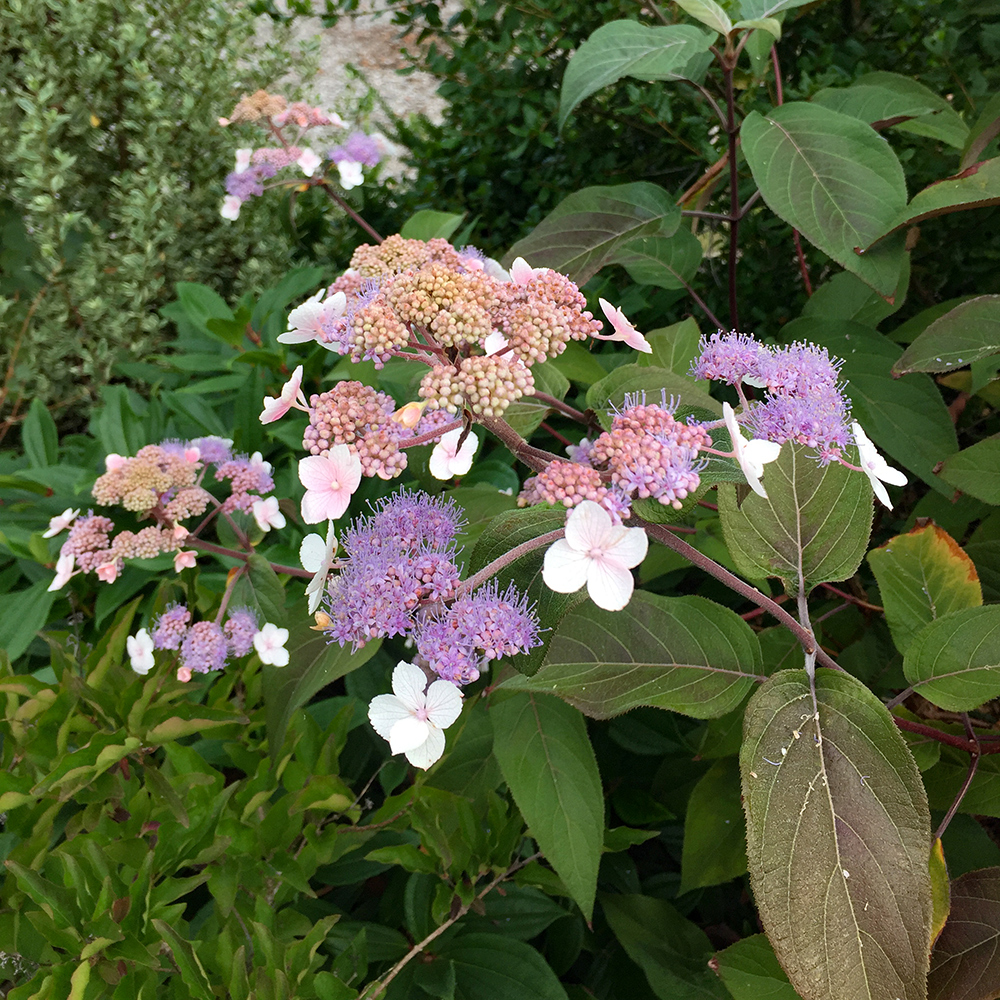
Choose carefully if you have deer problems
Deer seem to like to dine on oakleaf hydrangeas the most. However, bigleaf hydrangeas are also a favorite. If you have problems with deer browsing in your garden, smooth hydrangea and rough-leaved hydrangea are the best species to choose, as their fuzzy leaves are not as appealing.
Pruning is very type-specific
How to prune your hydrangea depends on your objective and the species you have. There are more than 75 species in this genus; some bloom on old wood (or growth) and others bloom on new wood. The growth that puts out the blooms is the key factor in determining the right pruning timing. The safest rule of thumb for all hydrangeas when it comes to deadheading spent flowers is to make the cut just below the spent flowerhead soon (if not immediately) after the flowers fade. Addressing a random floppy stem can be done on an as-needed basis.
However, when it comes to heavier, more structural pruning, after the flowers fade is also the best time for species that bloom on old wood. Species that flower on new wood can be structurally pruned in late winter before the new spring growth begins. If you are not sure of the species, start by deadheading it only, and then observe if your shrub blooms on new wood or old wood the following year. Here is a simple guide on when to prune the most common hydrangea types.
| Species | Produces flowers on | When to prune |
| Smooth hydrangea (H. arborescens and cvs., Zones 3–9) | New wood/growth | Early spring |
| Rough-leaved hydrangea (H. aspera and cvs., Zones 6–9) | Old wood/growth | Immediately after flowers fade |
| Climbing hydrangea (H. anomala ssp. petiolaris and cvs., Zones 4–8) | Old wood/growth | Immediately after flowers fade |
| Bigleaf hydrangea (H. macrophylla and cvs., and H. serrata and cvs., Zones 6–9) | Old wood/growth | Immediately after flowers fade |
| Panicle hydrangea (H. paniculata and cvs., Zones 4–8) | New wood/growth | Early spring |
| Oakleaf hydrangea (H. quercifolia and cvs., Zones 5–9) | Old wood/growth | Immediately after flowers fade |
Early spring is a good time to consider pruning, moving any hydrangeas that are in the wrong place, and planning out the next hydrangea purchase. New varieties of dwarfs, colors, and big bloomers are being regularly introduced. Keeping these guidelines in mind, enjoy adding more of these beautiful plants to your garden.
—Susan Calhoun is the owner of Plantswoman Design in Bainbridge Island, Washington.
Fine Gardening Recommended Products
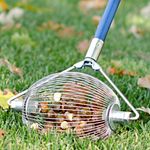
Medium Nut Wizard 14" for English Walnuts, Chestnuts, Golf Balls
Fine Gardening receives a commission for items purchased through links on this site, including Amazon Associates and other affiliate advertising programs.

Fiskars 15" PowerGear Loppers—Sharp Steel Blade Bush and Tree Trimmer
Fine Gardening receives a commission for items purchased through links on this site, including Amazon Associates and other affiliate advertising programs.
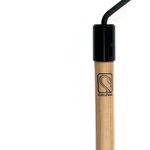
CobraHead® Long Handle Weeder & Cultivator Garden Tool
Fine Gardening receives a commission for items purchased through links on this site, including Amazon Associates and other affiliate advertising programs.



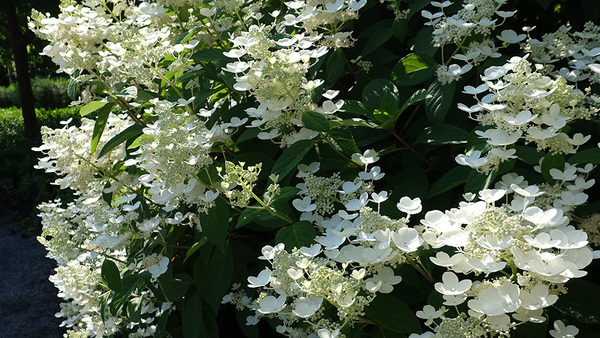















Comments
Log in or create an account to post a comment.
Sign up Log in